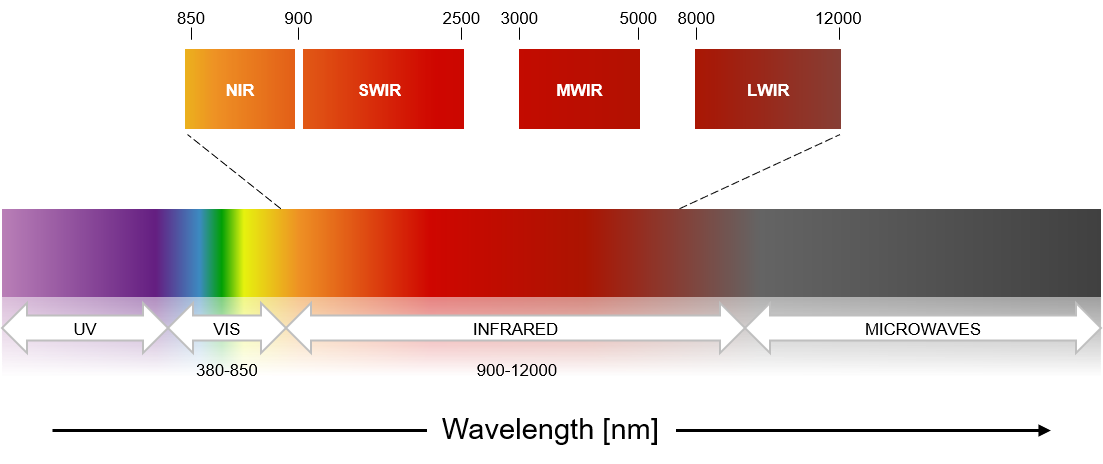Short-Wave Infrared or SWIR is an imaging technology that traditionally has been used in biological, defense, and some industrial-related applications. With the ever-growing need for camera systems that can see more than the human eye, engineers turned to the wavelength spectrum beyond the visible (VIS) space.

The infrared spectrum from 750nm to 12,000nm is broken down into two distinct sectors. The “reflected infrared” is represented by the Near-Infrared (NIR) and SWIR bands, and the “thermal infrared” is represented by Mid-Wavelength Infrared (MWIR) and Long-Wavelength Infrared (LWIR). Where the “thermal infrared” sensors detect light emitted by the object itself, NIR and SWIR sensors are detecting photons reflected by the object.
The 900 – 2500nm band is of particular interest as the ambient and background radiance emitted by stars during the night is a natural SWIR source, allowing for high contrast imaging. Also, water particles become transparent in the SWIR spectrum, hence eliminating a great shortcoming of systems relying on the visible spectrum only.
With technologies, materials, and manufacturing processes continuously advancing, we now see SWIR cameras in many more application areas. From agriculture, food processing, and medical imaging to quality control in automated production lines, security/surveillance, automotive, and even arts and archeology. Some of these applications leverage the release of new sensor technologies that simultaneously image the visible and SWIR wavelength bands (e.g., 400nm – 1700nm), and that offer increasing pixel-count (SXGA, VGA) and resolution (pixel pitch of 5µm).
The overall system cost needs to be reduced to foster wider adoption of SWIR Imaging. Relying on the ability of the new sensors that cover visible and SWIR spectrum in one camera alone is not enough, is the rest of the system is not innovating as well. The lens needs to support, if not even lead, this approach to eventually allow such broad coverage to expand the type of applications that can be addressed and the industries that can benefit from it.
So how are SWIR-imaging impacting lens design and manufacturing considerations?
The material choices and design considerations must be informed by and analyzed using the appropriate wavelength spectrum and weighting. The design and optimization approach will also be different. Sunex has a long-standing experience in hyperspectral designs that deliver a consistent high-performance over a vast spectrum. No matter the application requirements, VIS-only, VIS+NIR, VIS+SWIR, or SWIR-only, special considerations have to be made regarding the AR (Anti-Reflection) or BBAR (Broad-Based Anti-Reflection) coating to maximize the complete lens assembly transmission.
The R&D and manufacturing process often requires additional equipment (e.g., upgrade to MTF and Transmissivity tester to support the wavelength range), extra know-how for straylight testing and mitigations, and advanced coating experience. High MTF, small F/#, and low aberrations are typical for high-performing SWIR-lens. The exact performance parameters are typically driven by the application’s need and include the sensor choice and specific customer and end-user requirements.
Please Contact Sunex, to discuss your application-specific requirements, our available products & designs, and prototyping & manufacturing capabilities
Credits: Portrait Images (VIS, NIR, SWIR): NickSpiker, CC BY-SA 4.0, via Wikimedia Commons

